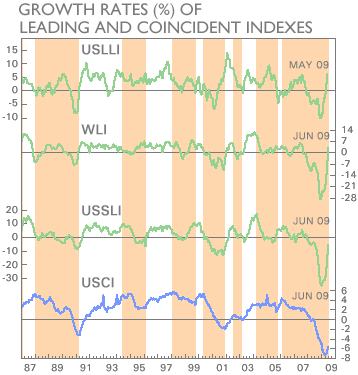Lakshman Achuthan is co-founder and managing director of the Economic Cycle Research Institute (ECRI), an independent organization focused on business cycle analysis and forecasting in the tradition established by ECRI’s co-founder, Geoffrey H. Moore. ECRI maintains business cycle chronologies for 20 countries around the world other than the U.S. Lakshman is the managing editor of ECRI’s forecasting publications and regularly participates in a wide range of public economic discussions.
He is a member of Time magazine’s board of economists, the New York City Economic Advisory Panel and serves as trustee on a number of non-profit boards. Lakshman is the co-author of Beating the Business Cycle: How to Predict and Profit from Turning Points in the Economy.
~~~
The modest pullback in stock prices that followed the springtime rally, along with a worse-than-expected June jobs report, allowed the skeptics to re-emerge, asserting that without actual improvement in hard economic data, the “green shoots” had wilted away. What they do not realize, as we reasserted in ECRI’s June U.S. Cyclical Outlook report to Professional Members, “is that the cyclical improvement in the economy is proceeding in a textbook sequence, from long leading indicators to short leading indicators to coincident indicators.” In fact, “there are now pronounced, pervasive and persistent upturns in a succession of leading indexes of economic revival.”
When approaching a cyclical turning point in economic growth, the growth rate of the U.S. Long Leading Index (USLLI) typically turns first, followed by the growth rate of the Weekly Leading Index (WLI), growth in the U.S. Short Leading Index (USSLI) and growth in the U.S. Coincident Index (USCI).
As noted in the report, “the levels of the USLLI, WLI and USSLI are now all rising.” In fact, as the nearby chart shows, by May USLLI growth (top line) had already surged to a four-year high. Meanwhile, WLI growth (second line) has spurted to a two-year high, having crossed over into positive territory. Following in their footsteps, USSLI growth (third line) has shot up to a one-year high, but is still in negative territory.
Finally, the USCI is still declining, indicating that as of June, the U.S. economic recovery had not yet begun. Yet, USCI growth (bottom line), which represents the rate of growth of aggregate economic activity, has risen for three months. While still in negative territory, it is now at a six-month high. Thus, the growth rate cycle upturn that we predicted in March has evidently begun.
But the sequential upswings in the leading indexes are not just about less negative growth. We clearly have “pronounced, pervasive and persistent upswings in a succession of leading indexes of economic revival – the most powerful possible predictor of a business cycle recovery. What is impressive here is the degree of unanimity within and across these leading indexes, along with the classic sequence of advances in those indexes. Such a combination of upturns does not happen unless an end to the recession is imminent,” as we noted in our June report.
If so, why is there such widespread doubt among analysts about an imminent end to the recession? The problem “is a widespread inability to distinguish among leading, coincident and lagging indicators, along with the vast majority of economic indicators that do not fall neatly in any of those three categories. Thus, indicators are typically judged by their freshness, not their foresight. Since most market-moving numbers are coincident to short leading, while corporate guidance is often lagging, it is no surprise that analysts do not discern any convincing evidence of an economic upturn.”
The arguments marshaled by standard bearers of the pessimistic consensus hold little water. Usually, their “analysis” is based on gut feel, bolstered by any seemingly plausible argument that would support their case.
For instance, last month, with oil prices and interest rates staging somewhat of an advance from their lows, skeptics opined that this would nip any potential recovery in the bud. But it is hardly unusual for such indicators to turn up in anticipation of economic revivals, which would never take place if higher oil prices or interest rates were able to head them off.
This month, the rise in the jobless rate to a 25-year high is being taken by some as an argument against recovery because supposedly, consumers will not spend when joblessness is mounting. Apparently, they are unaware that even the 1929-33 recession ended when the jobless rate was over 25% – and still rising!
The “second-derivative rally” in equities has provoked much derision, especially from those who missed it. As we reported last month, “ECRI’s leading indexes now have positive second derivatives. But, more importantly, they have already had positive first derivatives for some months. It is worth reminding calculus-challenged analysts who doubt the significance of these cyclical upswings of the second derivative test: when the first derivative of a univariate function rises to zero and its second derivative turns positive, it marks the low point of the function. That development is already in the rear-view mirror for every one of ECRI’s leading indexes of economic activity.”
In fact, “what is impressive here is the degree of unanimity within and across ECRI’s leading indexes, along with the classic sequence of advances in those indexes. Such a combination of upturns – a resounding confirmation of our April forecast that the recession will end this summer – does not happen unless an end to the recession is imminent.
In sum, the economy has a raft of problems that will take a long time to resolve. But none of them can head off the imminent economic recovery that ECRI’s objective leading indexes are promising today.”
Note: shaded areas in chart represent growth rate cycle downturns.



What's been said:
Discussions found on the web: